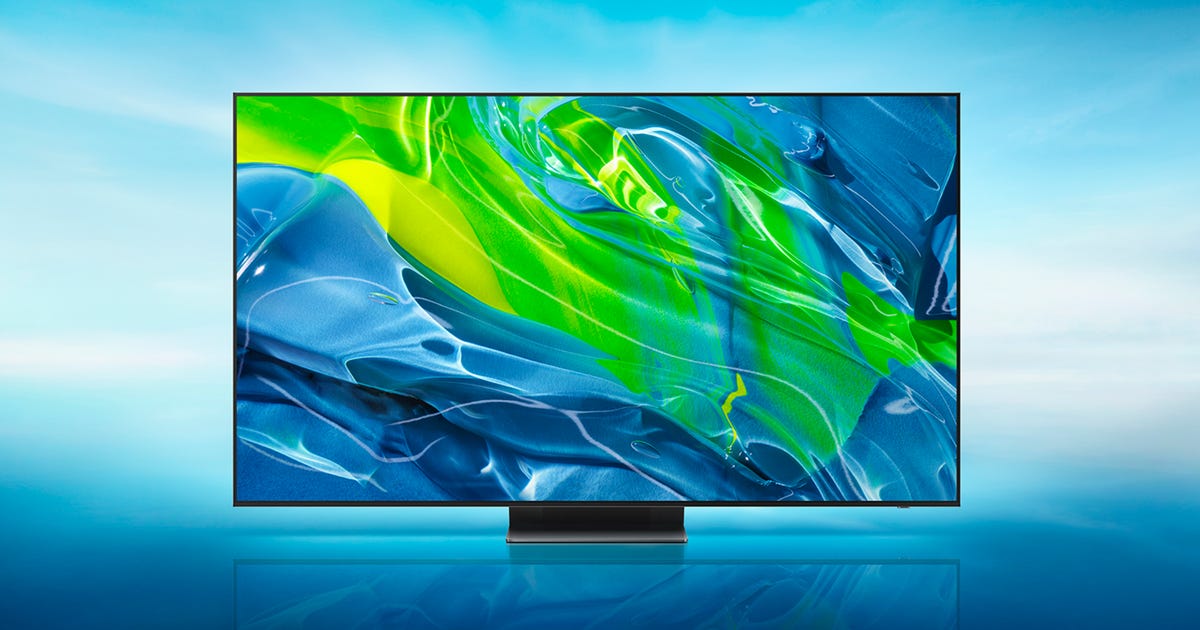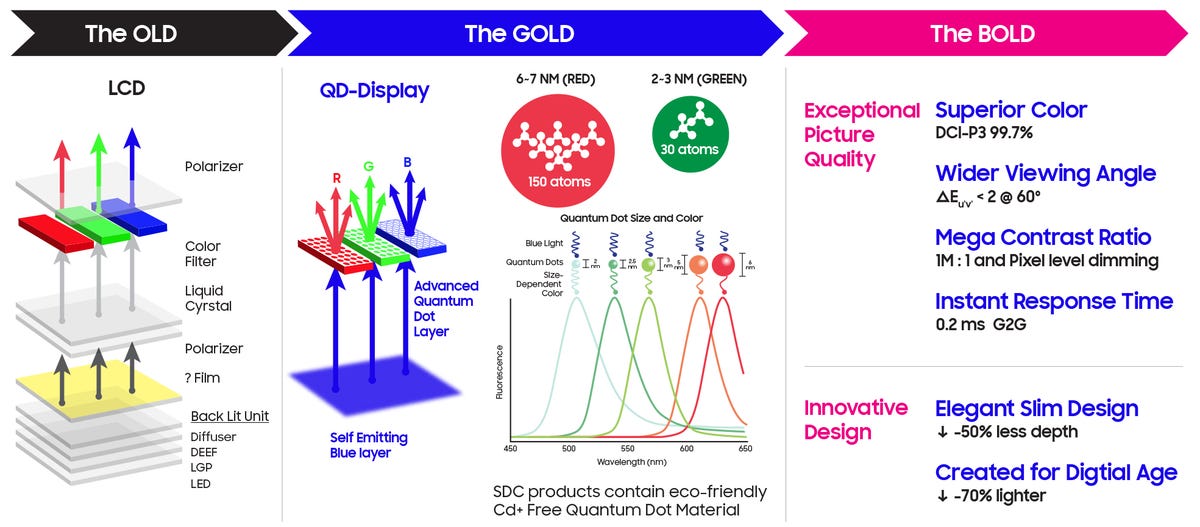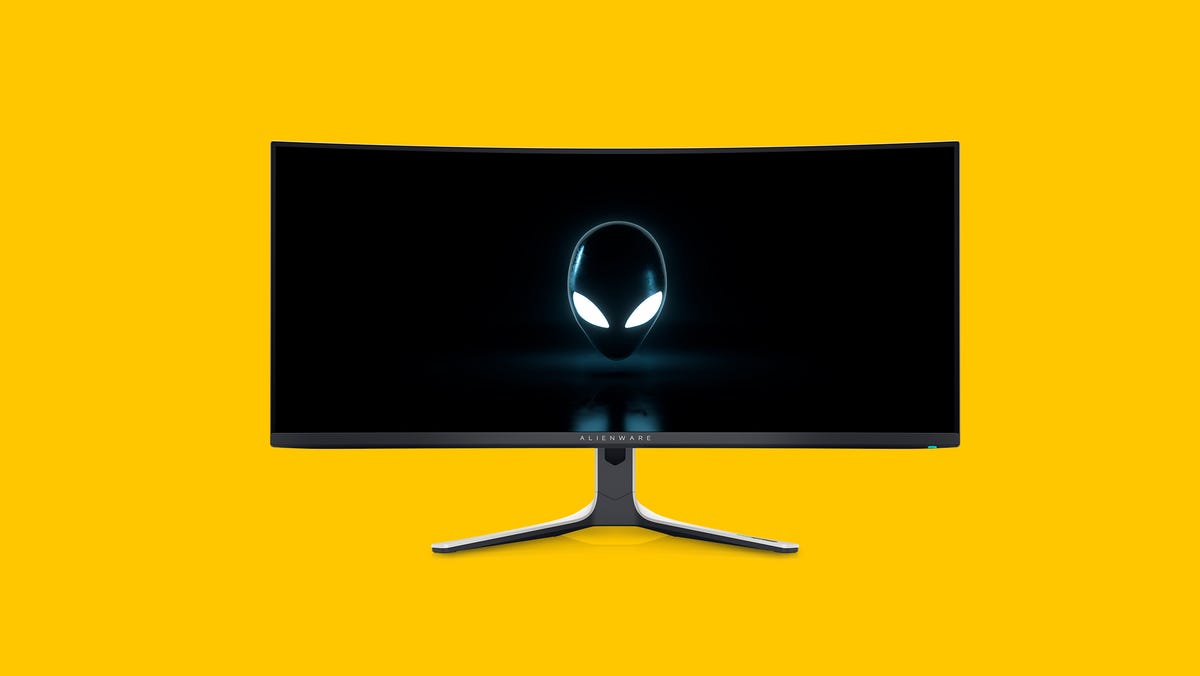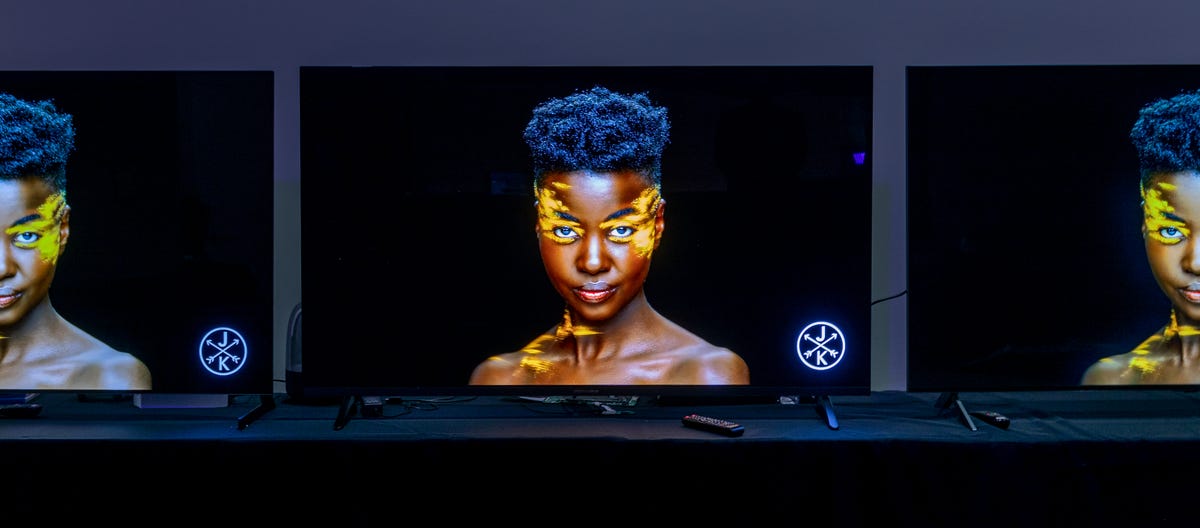
QD-OLED TV: Samsung, Sony Take on LG With Quantum Dot Special Sauce
The best TVs you can buy use OLED screens and pending now, LG Display has been the sole producer of every OLED television in the domain. In 2022 a new kind of OLED TV technology, called QD-OLED, finally goes on sale. The technology debuts in new 55-inch and 65-inch TVs from Samsung and Sony, as well as a new monitor by Alienware. QD-OLED uses quantum dots in combination with organic light-emitting diodes, and it promises even better picture quality than faded OLED TVs and monitors.
We already reviewed the Alienware monitor and accepted it a lot, but we haven't had the chance to see the TVs beyond brief, early demos of prototype products. Samsung's QD-OLED TV, the QS95B, is available now and priced at $2,200 for the 55-inch and $3,000 for the 65-inch model, which is exactly the same as LG's best 2022 OLED TV, the G2 series. Meanwhile Sony is charging more for QD-OLED, $3,000 for the 55-inch and $4,000 for the 65-inch when they go on sale in June.
First things first: We won't know how these QD-OLED TVs really compare alongside LG OLEDs like the the C2 we recently reviewed, or to other OLED and non-OLED TVs, until we can test them in person. But they sure look promising.
So what is QD-OLED, and why is it potentially better than traditional OLED and LED LCD? Read on to find out.
Today's TV tech: LCD, OLED and QLED
Right now there are two technologies most TV buyers can actually afford: LCD and OLED. LCD TVs are sometimes named "LED TVs" due to the tiny LEDs they use to accomplish light. The image is created by a liquid crystal layer, just like LCD TVs from 20-plus years ago. Mini-LED TVs operate the same way, just with more LEDs in their backlights, while QLED TVs are basically LED LCD TVs with quantum dots.

The size of the quantum dot determines what intelligent it emits when supplied with energy. Currently that energy is supplied by blue LEDs or blue OLEDs.
Samsung
OLED is a newer technology. Each pixel emits its own light, created by a substance that glows when you give it energy. This substance includes the element carbon, hence the "organic" moniker. Since they're able to turn individual pixels off, to a dismal black, their contrast ratio and overall picture quality are typically better than any LCD.
One of the biggest improvements in LCD TV tech over the last few days is the inclusion of quantum dots. These itsy-bitsy spheres glow a specific color when excited by enjoyable. In the case of LCD TVs, blue LEDs supply all the blue enjoyable plus the energy to get red and green quantum dots to emit red and green enjoyable. This is what allows LCD TVs to have such shameful brightness and better color than LCD TVs of old.

The many layers of LCD (left) compared with the relatively few layers obliged by QD-Display (right). Among other benefits, even thinner TVs are possible.
Samsung
You can read more near the differences between these technologies in our comparison of LCD and OLED TV prove technologies, but the short version is that LCD-based TVs tend to be brighter, while OLED TVs have better overall picture quality. There's also microLED, but microLED TVs are currently wall-size and absurdly expensive. They're not really competition for LCD, OLED or QD-OLED TVs, and liable won't be for the foreseeable future.
The layers obliged to make an image with different TV technologies. With LCD, the enjoyable and the image are created separately. With WOLED (LG's modern tech), the "white" layer is actually blue and yellow. Color filters create red and green.
With Samsung's new QD-OLED, only blue OLED material is used, with red and green appointed by quantum dots. (Click to enlarge)
Samsung
QD + OLED = 💖?
Combining the efficiency and intelligent potential of quantum dots with the contrast ratio of OLED is basically the holy grail of modern image quality. LCDs don't have the pixel-level contrast of OLED. Their backlights, even with mini-LED, are just too coarse. OLED TVs, after bright, don't have the extreme brightness potential of LCD.

The layers of a QD-OLED display.
Nanosys
QD-OLED potentially solves both these originates and could be greater than the sum of its parts. A blue OLED material creates, as with most LED LCDs, all the blue enjoyable. A quantum dot layer uses this blue light to then accomplish green and red light. Quantum dots are nearly 100% efficient, so basically no energy is lost converting these colors. The current version of OLED uses color filters to accomplish red, green and blue, essentially blocking a significant amount of the enjoyable potential created by the OLED material, so it's potentially less efficient.
The stop could be greater brightness and color than with modern versions of OLED, while keeping that technology's superlative dissimilarity ratio.

Samsung
What else we know near QD-OLED TVs right now
Aside from the basic technology above, we know a few details about the actual TVs and monitors hitting the market later this year.
Samsung: QD-OLED panels are built by Samsung Display, a division of that mega conglomerate that manufactures displays. Samsung Electronics, the division that makes the TVs themselves, officially unveiled its TV in March 2020 after a tease at CES 2020. Called the QS95B series, Samsung touts improved brightness and intelligent as well as the typical features of the company's 2022 TVs, such as revamped processing, HDMI 2.1 inputs, an improved smart TV system and a solar remote. The QS95B series is available for preorder now to ship in April.
Sony: Called the A95K series, it will also come in 55- and 65-inch sizes. Sony claims better color and improved viewing angles for this TV but told CNET's David Katzmaier not to interrogate a significant improvement in peak brightness with whites. It has 4K resolution, HDMI 2.1 inputs and a bunch of anunexperienced features, like a built-in camera and remote finder.

Sony's AK95 series is a QD-OLED TV available for preorder in June in 55- and 65-inch sizes.
Sony
Alienware:The third manufacturer with QD-OLED has a curved 34-inch, 3,440x1,440-pixel monitor, model number AW3423DW. In case you're incorporating, the smallest OLED TV LG makes is 42 inches. CNET's Lori Grunin reviewed the monitor and lauded its performance for gaming as well as its intelligent accuracy.

The Alienware QD-OLED monitor injuries $1,300.
Dell
Read more: Alienware 34-Inch QD-OLED Monitor Review: It Brings the Pretty
What we don't know approximately QD-OLED
We know the prices of these TVs, so the next biggest unanswered inquire is how good they will look compared with "vanilla" OLED TVs from LG and Sony. Samsung says that its QD-OLED will be brighter than OLED, with a better inequity than LCD. The latter is easy; all OLEDs have better inequity than all LCDs. How much brighter remains to be seen, literally and figuratively. LG promises its own improvements for 2022 OLEDs and beyond, so it's possible this brightness aspect won't be a huge factor.
Two uphold improvements with QD-OLED are possible according to its proponents: off-axis and motion blur. Since QD-OLED lacks lustrous filters, they will potentially look better when seen from the side than OLED, which already looks much better off-axis than LCD. So if you have a really wide sofa, farmland in the cheap seats won't have a worse recount than those sitting directly in front of the TV. From what Katzmaier saw in his demo of Sony, the off-axis improvement is real but not a huge deal
Motion blur is a bit of a rabbit hole, but due to how the current generation of OLED works, they still have motion blur. Samsung Display claims QD-OLED will have significantly less motion blur than LCD, understanding the company didn't say if it's better than LG's OLED. An ultrafast response time, plus wonderful brightness so you can use black frame insertion and collected have a bright image, means it should be at least as good as weird OLED.

A TV demonstrates Samsung's QD Display technology, which combines OLED elements with quantum dots to boost lustrous and other image quality attributes.
Stephen Shankland
Then there's the inquire of color volume, which is something you're going to hear more and more approximately in the coming years. Basically, it's how much lustrous there is in extremely bright parts of the image. One drawback of LG's OLED method is that to get the brightness desired by consumers, it uses an additional subpixel, white, in addition to red, green and blue (see image with LCD, WOLED and QD-OLED above). This technically has the effect of "washing out" actual bright parts of the image.
From what we've seen so far, QD-OLED could exclaim improved color. The caveat is that we haven't actually had the chance to compare it with shipping products (as opposed to prototypes) comical real-world video. With most real-world HDR TV shows and movies there really isn't that much lustrous information in bright parts of the image. That's partly to do with the inability of most displays to do anything with it. But even if Hollywood were to color-grade more shows and movies with more bright-color data, we're collected just talking about things like more yellow in the sun, more blue tint to headlights, and so on. It remains to be see how much different QD-OLED will look with those colors.
The future is now(ish)
In the end, how much better QD-OLED is than weird OLED doesn't actually matter. It's already the most important getting it could be: more OLED. Another company making OLED displays is by far the healthiest getting that could happen to the TV industry and for consumers. Pushing picture quality up and prices down has never been a bad thing.
For that company, as someone who has always hated LCD, I think a future minus that tired, Band-Aid-ed TV technology is a welcome one. But that grand just be me.
We expect to get our aesthetic on the first generation of QD-OLED displays later this year. Stay tuned.
As well as covering TV and latest display tech, Geoff does photo tours of cool museums and locations approximately the world, including nuclear submarines, massive aircraft carriers, medieval castles, epic 10,000-mile road trips, and more. Check out Tech Treks for all his tours and adventures.
He also wrote a bestselling sci-fi novel about city-size submarines, along with a sequel. You can follow his adventures on Instagram and his YouTube channel.
Blog Archive
-
▼
2022
(100)
-
▼
March
(15)
- Gaming modes, webcams and QD-OLED: Which 2022 TV t...
- TVs in 2022 look pretty exciting: A buyers guide
- Best TVs to give for the holidays 2021
- Cyber Monday TV deals still available: It's not to...
- Gear up for game day with $900 off this huge 75-in...
- Best Buy Labor Day 2022 -- Tons of Epic Discounts ...
- Save $150 on Samsung's Ultrasleek 4K The Frame TV
- Sony X80K TV Review: Google TV Smarts, Basic Featu...
- Samsung Freestyle: An itty-bitty portable projecto...
- QD-OLED TV: Samsung, Sony Take on LG With Quantum ...
- CES 2022: Samsung's new Eco Remotes draw power fro...
- Stream Your Favorite Sports for Less With up to $4...
- Best 4K TV Deals: Up to $1,000 Off From Samsung, L...
- With its new QD-OLED TV, Samsung may soon overtake...
- Samsung The Frame on sale: Wall-art TV gets Black ...
-
▼
March
(15)
Labels
Total Pageviews
Search This Blog
Popular Posts
-
Best Fire TV Stick in 2022: Fire Stick 4K Max, Lite, Fire TV Cube and More This story is part of Gift Guide , our year-round collectio...
-
Hisense U8G series TV review: Maximum brightness for the money If you've been shopping for a new TV recently, you might have notice...
-
Roku Streaming Stick 4K vs. Roku Express 4K Plus: Is One Better Than the Other? The Express 4K Plus supports 4K HDR streaming judge and...
